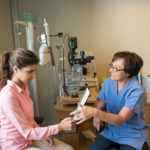 By Mark Wright, OD, FCOVD,
By Mark Wright, OD, FCOVD,
and Carole Burns, OD, FCOVD
Oct. 27, 2021
Some doctors choose not to follow what are known to be best practices. (Merriam-Webster defines best practices as: “a procedure that has been shown by research and experience to produce optimal results and that is established or proposed as a standard suitable for widespread adoption.”i)
We see examples of doctors not following best practices across the country. The question is why? Why would a doctor not follow what is known to be best for the patient? Here are the top two most common reasons we run into, and how to start doing what will help your patients and create a more profitable practice.
I’m a Doctor, Not a Sales Person
Some doctors view that prescribing glasses in the exam room (known to be a best practice) is different from prescribing a pharmacological agent that addresses the patient’s dry eye condition. In both cases, the purchase improves the patient’s life, but in both cases the purchase is not mandatory. It’s the doctors’ obligation to prescribe; it’s the patient’s choice to purchase.
So, why do some ODs believe prescribing glasses is different from prescribing eye drops? In both cases, something is purchased by the patient. Is the difference that one of those prescriptions may be purchased in the practice and the other is purchased somewhere else?
Perhaps it is the thought that prescribing something that the practice sells and makes a profit from is somehow different from examinations that the practice sells and makes a profit from. That appears to us to be logically the same.
Here’s another thought: Why is it OK for the patient to purchase glasses from some other organization, but it is somehow inappropriate for the doctor to prescribe glasses that the patient purchases from the practice? Merriam-Webster says, “Definition of sell (someone) on: to persuade (someone) to be interested in and excited about (something). He tried to sell them on the project.”ii The reality is you have to sell patients on taking their glaucoma medicine exactly as it was prescribed. No one questions sales in that context. Sales are only bad in the context that you are trying to get the patient to purchase something they do not need or want. From that perspective, indeed, sales are bad.
The inventor of dynamite was Alfred Noble. His invention was used violently during his lifetime to rob banks and blow up people. Some Nobel scholars suggest the Nobel Peace Prize was his way to compensate for developing such a destructive force. Keep in mind that dynamite has been used in incredibly positive ways such as building new roads and tearing down old houses to build new ones.
Just about anything that can be used for good can be used for bad. Here’s a thought: Decide to only use sales for good. Prescribe exactly what the patient needs to improve their quality of life and do not compromise the patient by prescribing less. And follow the best practice of doing this in the examination room.
I Don’t Know Enough About Glasses
Some doctors are OK with prescribing glasses in general, just not the specifics of the lenses. They often take the position that, “We’ve hired opticians for that. It’s their responsibility, not mine.”
The same doctors who punt spectacle lens specifics (e.g.: lens material, lens manufacturing process, AR, photochromics, sunglasses) to their opticians would never punt contact lenses specifics to the opticians. Why do these doctors prescribe the exact contact lenses needed for the patient in the exam room, but not the exact spectacle lenses needed by the patient? The most common answer we hear is: “We don’t know enough about spectacle lenses.”
Here’s a case to help us find out if we do know enough about lenses. A 53-year-old enters your clinic with complaints of near and intermediate blur. Their last vision exam was four years ago when the patient was prescribed CR-39 lined bifocals, which they are currently wearing. There are no current or previous health issues. Testing today (a comprehensive vision exam) shows no health concerns.
Other Articles to Explore
The patient drives due east every work morning at 7:30 a.m. for 30 minutes arriving at work with a mild headache which is not present on non-work days. The patient works on computers all day with the screen primarily in straight-ahead gaze and goes home at the end of the day with neck and back pain. There is a slight change in the distance Rx and a +1.00 D change at near. The patient is a weekend golfer with a +2 handicap. What brand-specific spectacle lenses with what brand-specific lens treatments should be prescribed for this patient?
Send your answers to the case question above to contactPMC@optometrybusiness.com and we will publish the answer in a future article.
Every OPT 4 student in the country and every optometrist in the country should be able to easily answer the question asked in the case above.
Opticians across the country tell us that when doctors prescribe in the exam room the specific lenses with the specific lens treatments the patient needs, two things happen: (1) it is easier to get the patient to accept the doctor’s treatment plan, and (2) the time the patient spends in the optical is reduced. Both of those are in the patient’s best interest.
Choose today to follow best practices and serve your patients’ best interests.
References
i. Best Practice | Definition of Best Practice by Merriam-Webster
ii. Sell (someone) On | Definition of Sell (someone) On by Merriam-Webster























